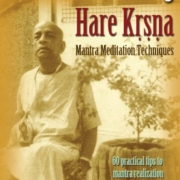Diksha is Personal
By: Mahanidhi Swami
The most significant, auspicious, beneficial and beautiful event in person’s entire material existence occurs when he/she receives diksha from Sri Guru. It is a momentous moment of transformation, elevation and elation that permanently establishes one on the path of liberation to the kingdom of God, Vraja prema or Vaikuntha moksha.
The candidate for diksha sits in the sacred space created just beside Sri Guru and Thakuraji Sri Krishna. It is confidential time; private, personal and intimate; hearts exchanging surrender and mercy, shishya sharanagati and Guru krpa.
Although based on thousands of years of tradition, and solid, scientific scriptural evidence, the whole transcendental function is very sweet, loving and above all completely personal. You alone sitting beside God incarnate Sri Guru.
As you read on, you will discover how personal and divinely endearing the timeless tradition of diksha is. According to shastra all Vaisnavas receive diksa by observing the pancha samskara process, or five rites.
Samskaras, which are purifying processes and rites used to sanctify the human body, are practiced in every religion in every country. For the last five hundred years of Gaudiya Vaisnavism, the pancha samskara process has been used by gurus to give diksha to worthy candidates. Acharyas Madhva and Ramanuja established it in their sampradayas. The Gaudiya Vaisnava sampradaya and practically all Vaisnava sects give diksha using the pancha samskara process.
This article will cite shastric evidence for the practice; describe the pancha samskara process and its application in the Gaudiya diksha tradition; and quote Srila Bhaktivinoda Thakura to highlight the absolute necessity of undergoing the pancha samskara process.
The pancha samskara process is mentioned in the Padma Purana and cited by our Gaudiya Vaisnava tattva acharyas Sri Jiva Goswamipada and Sri Baladeva Vidya Bhusana in Bhakti-sandarbha (anu. 200) and, Prameya Ratnvalli (8.5). Pancha samskaras are also mentioned in Sat-kriya-dipika attributed to Srila Gopala Bhatta Goswami. In recent times, Srila Bhaktivinoda Thakura described them in great detail in several articles and books. Iskcon’s Deity Worship Manual (Pancha Pradipa vol. 1) says, “The Guru gives the disciple Vaiñëava diksha which is also known as pancha samskara.”
Sri Jiva Goswamipada cites the Padma Purana (Uttara-khanda) in Bhakti Sandarbha anu. 200:
tapam pundram tatha nama, nama mantro yagash ca, panchama, ami panchaiva samskarah paraikanti hetavah
“The five samskaras (tapa, pundram, nama, mantra and yaga make one supremely one-pointed.” Or according to Bhanu Swami: “These five samskaras are the cause of intense devotion to Lord Hari.”
The process entails receiving the five marks of Vaisnava diksha: (1) Tapah (austerity i.e. follow the 4 niyamas, fasting etc.); (2) Pundram (tilaka); (3) Nama (accepting a new name i.e. Krishna dasa or Radhika dasi) ed. also includes receiving from Sri Guru the Hare Krishna mantra in the right ear; 4) Mantra (receiving the diksha mantra from Sri Guru in the right ear) ed. for Gaudiya Vaisnavas this means Gopala mantra and Kama Gayatri); 5) Yaga means yajna (homa, fire sacrifice) for some, but for most others it means Sri Murti puja and the nama-yajna of japa and sankirtana of the Hare Krishna Maha Mantra.
What are the benefits of receiving pancha samskara diksha? Sri Baladeva Vidya Bhusana answers, “A person who receives pancha samskara gains two things: 1) Chance to directly serve Lord Hari and; 2) Attain spiritual joy eternal in Vaikuntha, avapta pancha samskaro labdha dvi vidha bhaktikah, sakshat krtya harim tasya dhamni nityam pramodate.” (Prameya Ratnävali 8.5)
In the pancha samskara process Sri Guru and the disciple will sit physically together in the presence of Thakuraji i.e. the murti of Bhagavan Sri Krishna in one of His many beautiful forms. Then Sri Guru will personally administer the five marks of a Vaisnava (pancha samskaras) to his disciple. In addition to the pancha samskaras, a few other procedures are followed to complete the Gaudiya Vaisnava diksha function.
- Anga suddhi: To receive the diksha mantras, the disciple’s body must first be purified and consecrated. To do this, Sri Guru will chant different purifying vedic mantras while sprinkling sanctified water on the disciple’s head and other limbs. He will also direct the disciple in taking achamana, performing nyasa and chanting mantras to further purify and qualify the disciple to receive the immaculate and divine diksha mantras.
- Observe the Pancha Samskaras: Sri Guru will tell the disciple the yamas and niyamas or rules to follow (tapah). Sri Guru will personally apply tilaka (pundram) on the disciple’s forehead and other limbs. Sri Guru will give the disciple a spiritual name (nama). Then while holding his right hand on the disciple’s head, Sri Guru will whisper the diksa mantras in his right ear (mantra). Lastly, Sri Guru will engage the disciple making some offering to Thakuraji and Sri Guru (yaga).
- Atma Samarpanam: This last rite is an essential part of diksha which is observed in most all Gaudiya Vaisnava lineages. Atma samarpanam was personally introduced by Sri Chaitanya Mahaprabhu. It is also mentioned by our tattva-siddhanta acharyas Sri Jiva Goswamipada and Srila Sanatana Goswamipada.
The rite of atma samarpanam is done by the disciple falling at the feet of his Guru during diksha to express his atma samarpana, or the surrender of his entire being in the seva of Sri Guru and Sri Krishna.
Mahaprabhu said to Srila Sanatana Goswamipada (Cc. 3.4.192): diksha kale bhakta kare atma samarpana, sei kale Krishna tare atma sama, “At the time of diksha, the devotee completely surrenders to Sri Guru. Then Krishna gives the disciple a transcendental spiritual form like His own (in quality i.e. cid ananda maya (Cc. 3.4.191). Then in that transcendental spiritual form (aprakrta deha) the disciple can engage in worshiping (Krishna’s) lotus feet: sei deha kare tara cid ananda maya, aprakrta dehe tanra carana bhajaya (Cc. 3.4.193).”
Thus, based on Lord Gauranga’s statement above, one can understand that actual diksa means the disciple must offer dandavats at the feet of the physical Guru sitting before him. This point is confirmed by Srila Sanatana Goswamipada, and by Sri Jiva Goswamipada while describing Gaudiya Vaisnava diksa in Bhakti Sandarbha anu. 283. “One should offer pranams to the Guru [at the time of diksha] and offer everything to him”, ato gurum pranamyaivam sarvasvam vinivedya (v. 869). The same verse also appears in Hari-bhakti vilasa (2.9-10).
This is the process of Gaudiya Vaisnava diksha. From the above description, one can see that diksha is a very personal and intimate spiritual function between the merciful Sri Guru and his surrendered disciple. When one follows this process, he genuinely feels transformed, purified and elevated. Indeed, he becomes a spiritual being qualified to serve the lotus feet of Sri Sri Radha-Krishna right here right now. And soon not too far in the future that fortunate soul will attain Krishna prema, and go to Sridhama Goloka Vrindavana in the spiritual sky.
We will end our article with excerpts from Srila Bhaktivinoda Thakura’s wonderful and powerful explanation of Gaudiya Vaisnava diksha and the pancha samskara process.
Thakura Bhaktivinoda said, “Everyone should seek shelter at the feet of a Guru and receive pancha samskara diksha, which is the source of bhajana. Without pancha samskara, bhajana is performed with difficulty. Some people think that prema can be obtained without pancha samskara process but this is wrong. Without samskaras human life is impure.”
He closes his essay saying, “I have concluded after deep study of the shastra that without accepting the pancha samskara process, the conditioned soul will not develop intense love of Bhagavan Sri Hari. Therefore the pancha samskara process is absolutely necessary.” (“Pancha Samskara, the Process of Diksa” in Sajjana Toshani vol. 2.1 1885 & vol. 4.1 1892)
Gaudiya Vaisnava diksha ki jai!
Sri Krishna’s krpa-shakti murti Sri Guru ki jai!
Diksha mantras ki jai!
Jai Jai Sri Radhe!





Hello
Can I arrange to receive GURU DIKSHA PLEASE??
Let me know.
Thank you,
Rob
Calgary, Canada
Radhe Radhe Rob,
Here’s Maharaj answer:
“We are not giving diksa now”
yhs,